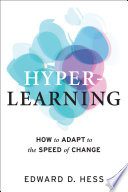

In today's fast-paced world, the ability to learn continuously is more important than ever. Hyper-Learning emphasizes that traditional education is no longer sufficient for success in a rapidly changing job market. Individuals must adopt a mindset of lifelong learning, constantly seeking new knowledge and skills. This involves not only formal education but also self-directed learning, online courses, and experiential learning. The book argues that embracing continuous learning allows individuals to adapt to new technologies and methodologies, making them more versatile and valuable in their fields.
Continue readingHyper-Learning highlights the role of technology in facilitating learning. The book discusses various digital tools and platforms that can enhance the learning experience, such as online courses, webinars, and collaborative tools. It emphasizes the importance of leveraging these technologies to access a wealth of information and resources that can aid in skill development. The integration of technology in learning processes not only makes education more accessible but also allows for personalized learning experiences that cater to individual needs and learning styles.
Continue readingA growth mindset is essential for hyper-learning. The book explains that individuals who believe their abilities can be developed through dedication and hard work are more likely to embrace challenges and persist in the face of setbacks. This mindset fosters resilience and encourages individuals to take risks in their learning journeys. Hyper-Learning provides strategies for cultivating a growth mindset, such as setting specific learning goals, seeking feedback, and reflecting on experiences. By adopting this mindset, individuals can unlock their potential and achieve greater success in their personal and professional lives.
Continue readingCollaboration is a key component of hyper-learning. The book emphasizes that learning is not just an individual endeavor; it often occurs in social contexts. Engaging with peers, mentors, and experts can enrich the learning experience and provide diverse perspectives. Hyper-Learning encourages readers to seek out collaborative opportunities, whether through networking, group projects, or online communities. By working with others, individuals can share knowledge, challenge each other's ideas, and foster a culture of learning that benefits everyone involved.
Continue readingThe ability to adapt to change is a core principle of hyper-learning. The book discusses the importance of being flexible and open to new ideas, especially in an era characterized by rapid technological advancements and shifting market demands. Hyper-Learning provides strategies for developing adaptability, such as staying informed about industry trends, experimenting with new approaches, and being willing to pivot when necessary. By cultivating adaptability, individuals can navigate uncertainty and thrive in dynamic environments.
Continue readingHyper-Learning emphasizes the importance of setting clear learning goals and measuring progress towards achieving them. The book suggests that individuals should define specific, measurable, achievable, relevant, and time-bound (SMART) goals to guide their learning efforts. Additionally, it encourages readers to track their progress regularly, reflecting on what they have learned and identifying areas for improvement. By establishing goals and monitoring their development, individuals can stay motivated and ensure that their learning efforts are aligned with their personal and professional aspirations.
Continue readingMindfulness plays a significant role in the hyper-learning process. The book discusses how being present and fully engaged in the learning experience can enhance retention and understanding. Mindfulness practices, such as meditation and focused attention, can help individuals manage distractions and improve their capacity to absorb information. Hyper-Learning encourages readers to incorporate mindfulness techniques into their learning routines, fostering a deeper connection with the material and promoting a more effective learning experience.
Continue reading